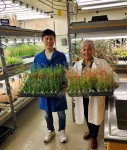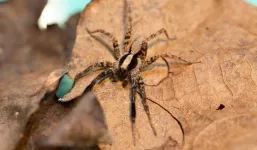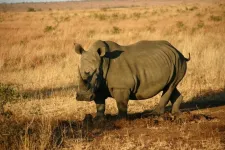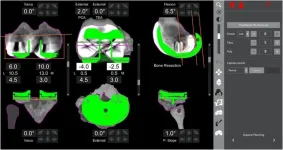(Press-News.org) Governor Kathy Hochul today announced that the City University of New York is receiving $75 million from the Simons Foundation, the University’s largest-ever donation. The gift earmarks $50 million to establish CUNY as a hub for computational science and $25 million to support CUNY’s participation in the Governor’s proposed Empire AI project. Computational science uses programming techniques to solve problems in fields such as biology, astrophysics and neuroscience.
“For many New Yorkers, higher education is critical to pursuing a career and building a brighter future for themselves,” Governor Hochul said. “This incredible donation from the Simons Foundation will help expand New York’s role in the future of AI at CUNY, preparing our students to fill the jobs of tomorrow right here in our state. With this funding, we are creating more opportunities for our students while solidifying New York as a leader in technology.”
The funding allows CUNY to create a new master’s degree program, hire new faculty, and create workforce opportunities for students and faculty at the nation’s largest and most diverse urban public university. The program, housed at the CUNY Graduate Center, will strengthen the University’s research and innovation capabilities and will build new career pathways into the advanced computer industry, projected to add over 300,000 new jobs in the coming decade.
The Simons Foundation’s $25 million to CUNY underwrites its participation in Empire AI, a state-sponsored consortium of New York’s leading research institutions to create a state-of-the-art artificial intelligence computing center to bolster research and development and unlock AI’s economic potential for the area.
Over the next five years, the $50 million gift will enable CUNY to:
Hire an initiative director in the first year and up to 25 faculty members over five years across multiple focus areas.
Provide support to develop a new Master of Science program at the CUNY Graduate Center.
Conduct workshops and lectures by visiting scholars and fund conference travel for faculty and students.
Strengthen the degree-to-career pipeline by providing research experience for undergraduates, tuition subsidies and fellowship stipends for master’s students, as well as fellowship stipends for the summer and academic year to enable Ph.D. students to serve as mentors for undergraduate researchers.
This investment builds on CUNY’s reputation as a top tier research institution with alumni winning 13 Nobel Prizes and 26 MacArthur “Genius” Grants. In 2023, the University raised a record-setting $633.2 million in external funding for research and other sponsored programs, advancing a key strategic priority to strengthen CUNY’s research ecosystem. Collectively, CUNY research grants total about $500 million each year, for more than 2,100 active research grants. The generation of knowledge by more than 10,000 faculty scholars and staff produces transformative advances for New York City, New York State and beyond. Significantly, this research is carried out by a diverse collection of students and faculty from across the five boroughs. CUNY researchers are working to reduce disparities in public health, mitigate urgent impacts of climate change and make advancements in STEM.
CUNY Chancellor Félix V. Matos Rodríguez said, “CUNY is deeply grateful to the Simons Foundation for this historic investment. This generous gift, reflecting our position as a research powerhouse with more than 10,000 researchers and an engine of upward mobility for a student body in which 60% are first-generation college students and more than 80% are persons of color, will propel CUNY to the forefront of research and guarantee access for our diverse community. With this support from the Simons Foundation, CUNY reaffirms its mission to promote educational equity and advance its role as a driver of inclusive growth in New York.”
Simons Foundation President David Spergel said, “This gift aims to strengthen computational research at CUNY, to build on its traditions of excellence, its record of inclusion and opportunity, and to enable outstanding students and researchers to have the tools needed to be at the forefront of the field. We were inspired by the Governor’s investment in Empire AI to deepen our investment in CUNY. New York will be the center of computational science and computer science. CUNY’s faculty and students will be a vital part of this scientific revolution.”
CUNY Graduate Center Interim President Joshua Brumberg said, “The Graduate Center has grown its investment in science education and research over the past decade to include new master’s programs in Cognitive Neuroscience, Astrophysics and Data Science. These areas of research can be rapidly advanced by the application of computational techniques that allow us to ask and solve complex problems. Simons’ investment recognizes that we are ideally positioned to create this new program, help grow New York as a center of computational science research and ensure diversity in this cutting-edge field.”
END
Governor Hochul announces CUNY to receive $75 million from the Simons Foundation, largest donation in university history
$50 million will create 25 more faculty positions and a new master’s degree in computational science and 25 million contribution designated for university AI research
2024-01-17
ELSE PRESS RELEASES FROM THIS DATE:
Keys to aging hidden in the leaves
2024-01-17
Scientists have known about a particular organelle in plant cells for over a century. However, UC Riverside scientists have only now discovered that organelle’s key role in aging.
The researchers initially set out to understand more generally which parts of plant cells control plant responses to stress from things like infections, too much salt, or too little light. Serendipitously, they found this organelle, and a protein responsible for maintaining the organelle, control whether plants survive being left too often in the dark.
Because they had not expected this discovery, which is ...
Rain can spoil a wolf spider’s day, too
2024-01-17
If you hate the rain, you have something in common with wolf spiders.
Researchers at the University of Cincinnati found that wolf spiders can’t signal others or perceive danger from predators as easily on rain-soaked leaves compared to dry ones. Even communicating with would-be mates is harder after it rains.
The study was published in the Journal of Insect Behavior.
Biologists in UC’s College of Arts and Sciences studied Schizocosa ocreata, a wolf spider found across much of the United States. Males respond to chemical signals from females by using a combination of visual ...
Independent dispute resolution of no surprises act financially unviable for radiology
2024-01-17
Leesburg, VA, January 17, 2024—According to the American Journal of Roentgenology (AJR), the No Surprises Act’s (NSA) independent dispute resolution (IDR) process would be financially unfeasible for a large portion of out-of-network (OON) claims for hospital-based specialties—more so for radiologists than other specialists.
“Although the NSA enacted important patient protections, IDR fees limit clinicians’ opportunities to dispute payer-determined payments and potentially undermine their bargaining power in contract negotiations,” ...
AMS presidential forum to address “Climate Science as Service to Society”
2024-01-17
[Boston, MA—January 17, 2024] The American Meteorological Society (AMS) will open its 104th Annual Meeting with a Presidential Forum on how to advance society’s acceptance and use of climate science. Distinguished atmospheric scientist Dr. Kerry Emanuel will moderate a “fireside chat” with Monica Medina, President and CEO of the Wildlife Conservation Society and former Deputy Assistant Secretary at the State Department, and Bob Inglis, Executive Director of RepublicEn.org and former congressman from South Carolina. The Forum, with opening remarks by AMS President ...
Researchers find anti-HIV drugs may prevent complications from bacterial sepsis
2024-01-17
Bacterial infections can lead to the formation of abscesses — pockets of dead cells and debris surrounded by inflammatory immune cells. Bacteria multiply within abscesses, causing more inflammation and further damage to surrounding tissues. In severe cases, these immune reactions spread across the body, resulting in life-threatening organ failure, or sepsis. But how these abscesses form and what can be done to prevent them were previously not well understood.
Using preclinical models, investigators from Brigham and ...
The heat is on: UMass Amherst scientists discover southern Africa’s temps will rise past the rhinos’ tolerance
2024-01-17
January 17, 2024
The Heat is on: UMass Amherst Scientists Discover Southern Africa’s Temps Will Rise Past the Rhinos’ Tolerance
New research shows that rising temperatures caused by climate change are impacting the remaining black and white rhinoceros populations on the African continent, suggests taking steps to mitigate impact now
AMHERST, Mass. – Southern Africa contains the vast majority of the world’s remaining populations of both black and white rhinoceroses ...
Next generation spinal fusion goes "meta"
2024-01-17
A civil engineer at the University of Pittsburgh is applying his expertise in bridges and infrastructure to develop new materials that better treat spinal injury, repair, and recovery. Amir Alavi’s proposal received a $557,000 boost from the National Institutes of Health to test the first “metamaterial” orthopedic implants.
With an estimated 342,000 procedures per year in the U.S.1, interbody spinal fusion is a popular procedure to treat a range of spinal pain and injuries, from herniated discs and degenerative diseases to trauma. Interbody fusion cages are spinal implants that are used in most of ...
Study identifies new findings on implant positioning and stability during robotic-assisted knee revision surgery
2024-01-17
HUNTINGTON, W.Va. - An innovative study at Marshall University published in ArthroplastyToday explores the use of robotic-assisted joint replacement in revision knee scenarios, comparing the pre- and post-revision implant positions in a series of revision total knee arthroplasties (TKA) using a state-of-the-art robotic arm system.
In this retrospective study, the orthopaedic team at the Marshall University Joan C. Edwards School of Medicine and Marshall Health performed 25 revision knee replacements with a robotic assisted computer system. The procedure involved placing new implants at the end of the thighbone and top of the shinbone with the computer's aid to ensure ...
New vaccine design uses immunity against influenza to offer faster protection against emerging pathogens
2024-01-17
RIVERSIDE, Calif. -- After COVID vaccination, it usually takes weeks for our bodies to develop protective antibody responses. Imagine, however, a vaccine that speeds up the production of antibodies against SARS-CoV-2, the virus that spreads COVID-19.
A research team led by Rong Hai, an associate professor of microbiology and plant pathology at the University of California, Riverside, has developed such a vaccine by using preexisting immunity to a separate virus (the influenza virus) to help kickstart the process of making antibodies ...
How do controllable risk factors for dementia vary by race, ethnicity?
2024-01-17
MINNEAPOLIS – Approximately 23% of people diagnosed with Alzheimer’s disease or another related dementia in their 60s and later have cases that can be explained by controllable risk factors such as high blood pressure, diabetes, physical inactivity, and too little or too much sleep, and that percentage varies depending on race and ethnicity, according to a new study published in the January 17, 2024, online issue of Neurology®, the medical journal of the American Academy of Neurology. When including APOE ε4, a gene variant associated with the strongest genetic risk for late-age Alzheimer’s disease, the study found about a third of cases could be explained ...
LAST 30 PRESS RELEASES:
Numbers in our sights affect how we perceive space
SIMJ announces global collaborative book project in commemoration of its 75th anniversary
Air pollution exposure and birth weight
Obstructive sleep apnea risk and mental health conditions among older adults
How talking slows eye movements behind the wheel
The Ceramic Society of Japan’s Oxoate Ceramics Research Association launches new international book project
Heart-brain connection: international study reveals the role of the vagus nerve in keeping the heart young
Researchers identify Rb1 as a predictive biomarker for a new therapeutic strategy in some breast cancers
Survey reveals ethical gaps slowing AI adoption in pediatric surgery
Stimulant ADHD medications work differently than thought
AI overestimates how smart people are, according to HSE economists
HSE researchers create genome-wide map of quadruplexes
Scientists boost cell "powerhouses" to burn more calories
Automatic label checking: The missing step in making reliable medical AI
Low daily alcohol intake linked to 50% heightened mouth cancer risk in India
American Meteorological Society announces Rick Spinrad as 2026 President-Elect
Biomass-based carbon capture spotlighted in newly released global climate webinar recording
Illuminating invisible nano pollutants: advanced bioimaging tracks the full journey of emerging nanoscale contaminants in living systems
How does age affect recovery from spinal cord injury?
Novel AI tool offers prognosis for patients with head and neck cancer
Fathers’ microplastic exposure tied to their children’s metabolic problems
Research validates laboratory model for studying high-grade serous ovarian cancer
SIR 2026 delivers transformative breakthroughs in minimally invasive medicine to improve patient care
Stem Cell Reports most downloaded papers of 2025 highlight the breadth and impact of stem cell research
Oxford-led study estimates NHS spends around 3% of its primary and secondary care budget on the health impacts of heat and cold in England
A researcher’s long quest leads to a smart composite breakthrough
Urban wild bees act as “microbial sensors” of city health.
New study finds where you live affects recovery after a hip fracture
Forecasting the impact of fully automated vehicle adoption on US road traffic injuries
Alcohol-related hospitalizations from 2016 to 2022
[Press-News.org] Governor Hochul announces CUNY to receive $75 million from the Simons Foundation, largest donation in university history$50 million will create 25 more faculty positions and a new master’s degree in computational science and 25 million contribution designated for university AI research




